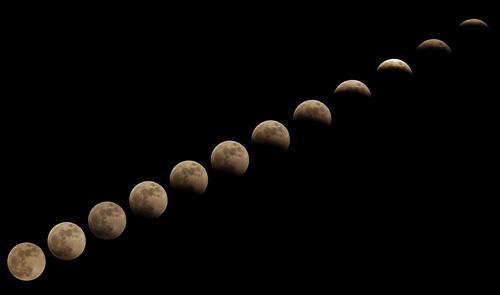Lunar Eclipse Tonight!

Here’s one of the many fabled stories of how lunar eclipses have influenced history:
A lunar eclipse bailed Christopher Columbus out of a jam in Jamaica in 1504. Stranded there, ships damaged on a follow-up voyage to what would be called the Americas, Columbus and crew were starving because the natives refused to trade food for trinkets. The wily explorer consulted an almanac and learned a lunar eclipse would occur on Feb. 29, 1504. On that day, Columbus told the natives that God frowned on their lack of hospitality and would remove the moon from the sky if they didn’t cooperate. The eclipse made good on the warning. The spooked natives promptly offered food if Columbus would bring back the moon, which natural events did for him. Well-supplied, Columbus and crew ultimately made it back to Europe.
While unlikely to improve relations with your neighbors, it’s worth stepping out to see tonight’s lunar eclipse. USA Today ran a great viewing guide yesterday. Some highlights:
- Nearly a billion people in the Western Hemisphere, more than 1.5 billion in Europe and Africa, and perhaps another half-billion in western Asia will be able to watch — weather permitting…
- The only problematic area will be along the Oregon and northern California coast, where the first partial stage of the eclipse will already be underway when the moon rises…
- This eclipse comes with a rare bonus. The planet Saturn (magnitude +0.2) and the bright bluish star, Regulus (magnitude +1.4) will form a broad triangle with the moon’s ruddy disk….this upcoming double event will be the only one of its kind occurring within the next millennium!
The European Space Agency and NASA both have viewing information, as well. For those in North America, this map tells you the time the eclipse will begin in your location. The short of it: 10:01 pm Eastern.
NASA also explains the color change during totality:
During an eclipse the moon changes color, going from a light gray color to an orange or deep red shade. This is totality. The moon takes on this new color because indirect sunlight is still able to pass through the Earth’s atmosphere and cast a glow on the moon.
The exact color that the moon appears depends on the amount of dust and clouds in the atmosphere. If there are extra particles in the atmosphere, from say a recent volcanic eruption, the moon will appear a darker shade of red.
I can’t think of any recent volcanic eruptions, do dark red may not be in the picture.
The next lunar eclipse will be on Dec. 21, 2010.
